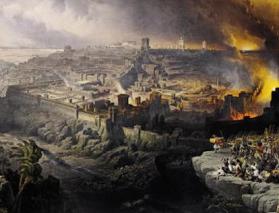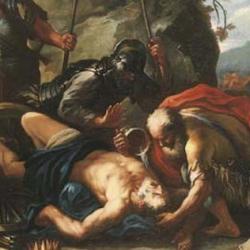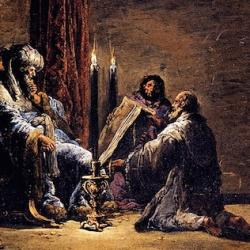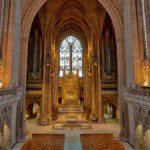David assembles the leaders of Israel for Solomon’s coronation (1 Chronicles 28–29; cf. 29:22), and, even more importantly, to encourage them to contribute skill, energy, and material to the temple, King Yahweh’s fortress. Judged by terminology used elsewhere in the Old Testament, his descriptions of the temple are eccentric.
Initially, he describes his own desire to build the temple as a “house of rest for the ark of the covenant of Yahweh and the footstool of our God” (28:2). The sanctuary is associated with rest (menuchah, cf. noach) elsewhere, most notably in Deuteronomy 12. But the phrase “house of rest” is unique. It highlights the political setting of Israel (rest on every side), Yahweh’s enthronement (He rests on His throne in His house), the achievement of admittedly pre-eschatological Sabbath.
If we had only verse 2 to go by, we would think that the ark was alone in the temple. As David continues, it becomes clear that there are other things in the temple, but it is pre-eminently a resting place for the ark—the ark that has been wandering from place to place since Hophni and Phinehas took it out to the battle of Aphek (1 Samuel 4). It has been in Aphek, Philistia, the house of Abinadab, the house of Obed-edom, finally in Jerusalem in the tent. With the temple, it gets a permanent home.
The description, “house of rest for the ark of the covenant” suggests that the temple is basically an extension of the Davidic ark-shrine, the tent that he built to house the ark after David brought it into Jerusalem (1 Chronicles 16:1). The temple exists for the sake of this one piece of furniture; all the other structures and furnishings are oriented to serving the throne of Yahweh. The temple is a throne room, the divine equivalent to Solomon’s “hall of the throne” (cf. 1 Kings 7:7).
The description of the ark is equally eccentric: “the ark of the covenant of Yahweh and the footstool of our God.” The latter phrase is the oddity. There is some question about how to take the waw (“and”) between “ark” and “footstool.” Are these two objects, or is this an epexegetical waw, translatable as “even”? The preposition “for” (le) is repeated—“for the ark . . . and for the footstool,” which implies that the two objects are distinguishable. More generally, the ark apparatus as a whole is best understood as Yahweh’s throne. David’s phrase distinguishes the coffer-ark and the kapporet or covering, which would be the footstool. Yahweh is enthroned above the cherubim, but He rests with His feet on the footstool of the ark-cover.
When David describes the tabnit (plan, blueprint, pattern) for the temple, his terminology is again unusual. It is called the “tabnit of the ulam,” which has associated houses, treasures, upper rooms, inner rooms, and a “house for the ark-cover (kapporet)” (28:11). In Kings, ulam isn’t the name for the temple as a whole, nor for the main interior. That space is designated as the heykal, the “palace.” (Elsewhere in 1 Chronicles, “temple” translates biyrah, perhaps a Persian loan-word meaning “citadel” or “fortress.”) The ulam is an open area in front of the palace, usually translated as “porch” (1 Kings 6:3). In 28:11, the temple is named by reference to this entryway, and even the “house of the kapporet” is seen as an area associated with the porch. It’s like naming the city of Jerusalem by using the names of one of its gates.
That the inner sanctuary (apparently) is described as the “house of the kapporet” again highlights the connection between David’s ark-shrine and the temple. The temple is not described as the place where Yahweh’s sets His name, nor the house for all of Yahweh’s furnishings. It is described by reference to the central item of furniture, the item that was placed in David’s tent. And the accent is on the ark-cover as much as on the ark itself.
Finally, David hands over the plans for the “chariot” (28:18; Heb. merkabah), explained as “the cherubim, that spread out (parash) their wings and covered (sakak) the ark of the covenant of Yahweh.” In Kings, the only chariot-like structures were the water basins in the court (1 Kings 7:33). The description in 1 Chronicles 28:18 resembles the description of the golden cherubim in Exodus 25:18-20, part of the description of the kapporet. These cherubim “spread” (parash) wings to “cover” (sakak) the kapporet. The fact that David’s plan designates the weight of gold for the chariot strengthens the link.
But: Why would David need to make the golden cherubim on the cover of the ark? Hadn’t Bezalel already made them? David refers instead to the two free-standing cherubim that were added to the assembly in the Most Holy Place. 2 Chronicles 3:10–13 describes them, and indicates that they were “overlaid” with gold. These cherubim are new to the temple, and it is apparently these cherubim that turn the “ark” into a “chariot.” The two new cherubim mobilize the Lord’s throne-and-footstool.















